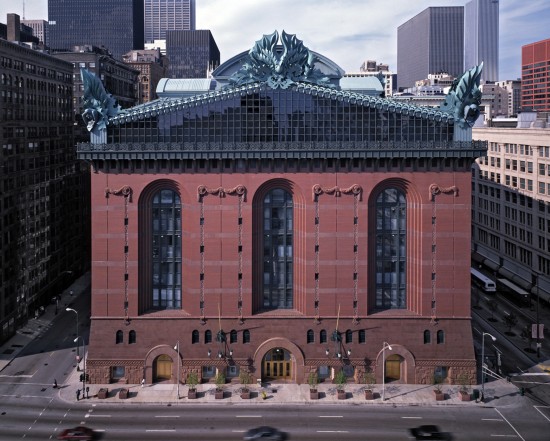Celebrity architect death match: Ito vs. Beeby

In this corner: Pure, elite modernism. And in this corner: Classically inspired eclecticism.
It's awards season in the architecture world, and the two most-watched prizes -- the Driehaus and the Pritzker -- have wound up in a heavyweight matchup worthy of a barroom brawl. The two winners each can claim a career inspired by rejecting modernism.

But only one really deserves this lofty title.
Lots of people know The Pritzker Architecture Prize, brought to us by Chicago's nice Hyatt family. Billed as architecture's Nobel prize, the laurels go to the big dogs: I.M. Pei, Norman Foster, Zaha Hadid, Frank Gehry. The jury includes globetrotting thought leaders; oddly, Supreme Court Justice Stephen Breyer is among them.
Dueling prizes
This year's Pritzker winner is Tokyo-based Toyo Ito, whose minimalist works convey supreme elegance, lightness and purity. He gets a hundred grand and a bronze medal.
Not to be outdone, The Richard H. Driehaus Prize offers a $200,000 purse via the University of Notre Dame, where the award was founded by its namesake philanthropist in 2003 to fight back against the modern menace of the Pritzker.
Aptly, this year's winner is Thomas H. Beeby, a Chicago architect whose legacy is about busting out of the modernist glass box.
A few critics also allow Ito the same claim to fame. But don't buy it.
Urban Robot vs. Exquisite Corpse
Ito, arguably today's most powerful Japanese architect, has taken modernism to new heights, bringing new technology, form and ideas to the world of building. His contributions include the compelling notion of "electronic modernism." Ito tweaks the grid and warps the plane. His early White U house (1976) was the inverse of the Glass House: a dark, oppressive tomb. But his most influential designs are bright and delicate, and remain in the realm of distilled, radically innovative modernism.
In Frank Lloyd Wright's suburb of Oak Park, Illinois, we find a very different protagonist.
Beeby's posse was the Chicago Seven -- no, not the rioting 1968 antiwar protesters, but a group of architects who rejected the growing influence of European modernism, back in the day. They looked at the 1970 show at the Museum of Contemporary Art, One Hundred Years of Architecture in Chicago, and saw Ludwig Mies van der Rohe taking over the world.
"Danger! We must stop him," they said, and they planned a deft counterpunch.
The group, including the great Stanley Tigerman, Ben Weese, James Ingo Freed (and later, Helmut Jahn) planned their own protest show, The Exquisite Corpse. With Palladian blocks and barrel vaults, it was the dawn of the Postmodernism (Pomo) era. Philip Johnson and Robert A.M. Stern took up the cause elsewhere.
Pomo mixmasters fight global mods!
The 1977 book, The Language of Post-Modern Architecture, by critic Charles Jencks codified the architects' belief system: that classical and modern elements can be married and muddled together in a delightful expression of contemporary life.
Yet after a decade or so of Pomo persuasion, the modernists began to pull ahead. In addition to the purity and dogma of the International Style, new ideas in mod emerged: The funky, the techie and the blobby, among others. Ito the Urban Robot, as his firm was originally dubbed, showed the way. Ito considered the impact of digital technologies on architecture, and he called his Sendai Mediatheque an example of "fluid space."
Beeby's life cause has been quite different. Rather than a top-down conceptualist, he's more like the kid from the block. The "harmonious variety of a cityscape" emerges "through minimally controlled 'accident,' " as Architectural Record opined in 1978.
The result is so mixed as to mystify the critics, while thrilling the locals. At its least creative, Beeby's vision renders the ultra-orthodox U.S. courthouse in Tuscaloosa, Alabama, its Classical Greek purity totally out of time. Yet this 2011 building is beloved, both by the Feds and neighbors. But the height of Beeby's genius, I say, is the 1991 Harold Washington Library in Chicago, with its fantastic and figurative ornamental flourishes.
Tom for the masses, or Toyo's elites?
We need both of these architects today. Both have been influential (Beeby was dean at the Yale School of Architecture, from 1985 to 1991). Both are world-class innovators.
Ito's school dominates international discourse, but we wonder if his works connect with the human spirit. The White U house upset his own family members. Often, his gorgeous compositions and evanescent materiality seem to come from the future, from outer space.
Beeby's solutions seem both tactical and emotional.Yet his achievements are no less glorious. The "critical spirit" of Beeby's Chicago Seven, says the city's savvy architecture critic, Blair Kamin, helped "alter the course of the city’s architecture.”
Ladies and gentlemen: In this corner, Tom Beeby, the 11th Driehaus laureate, representing a fusion of architectural tradition. In the other corner, the 2013 Pritzker winner, Toyo Ito, a global nomad and soldier of the digital revolution.
Who has done more for humanity? The winner this time, it seems, isn't the Pritzker honoree.
This post was originally published on Smartplanet.com